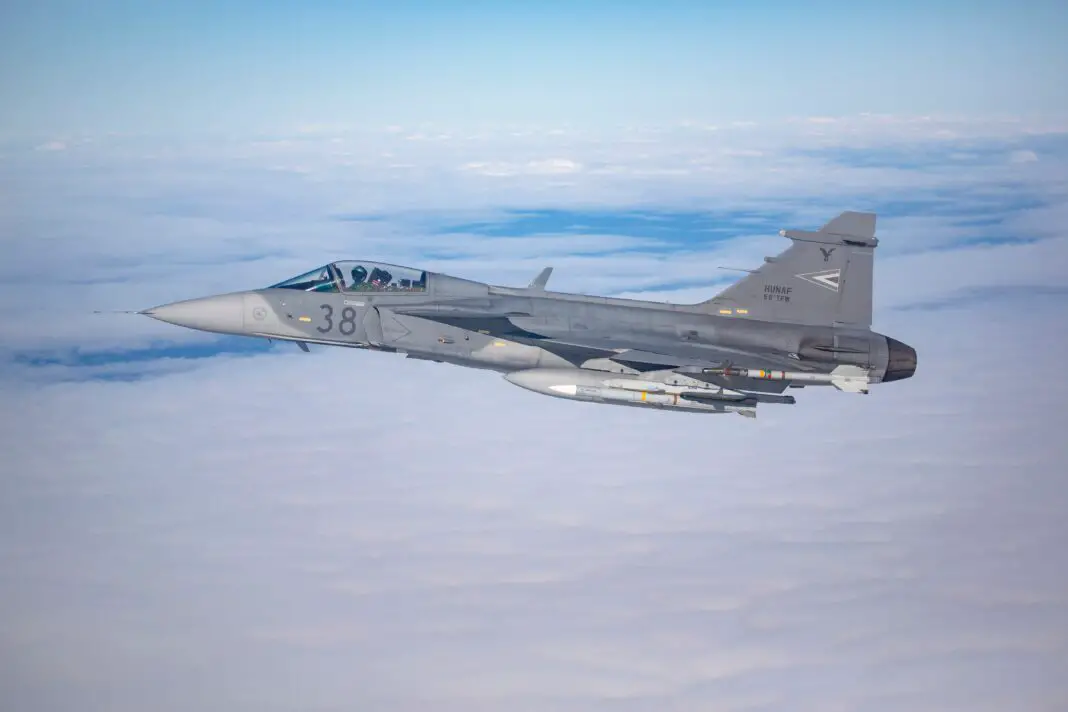The 14 Gripen C/Ds leased by the Hungarian Air Force will receive the MS20 Block 2 modernization, which improves radar capabilities, communications and broadens the range of weaponry they can deploy.
According to Saab’s press release, the upgrade program to be implemented by the company is the result of negotiations between the Hungarian Government Commissioner’s Office responsible for defense development and the Swedish Defense Materiel Administration (FMV).
The MS20 Block 2 upgrade brings a number of improvements. It greatly increases the Gripen’s combat and communication capabilities, as well as access to a wide range of weapons that can be integrated into Hungarian Air Force (HunAF) Gripen fighters.
Radar
Sensor capability is vastly improved by an upgrade to the PS-05/A Mk 4 radar, which means that the air-to-air target tracking range, as well as performance, is significantly increased. This enables better small air-to-air target detection capability, improved jamming suppression and brings growth potential for new developments in air-to-air and air-to-ground modes.
Communications
The MS20 Block 2 upgrade for the HunAF Gripen fleet also enhances communications capabilities by improving Link16 (NATO data link) functionality and upgrading voice communication to the latest NATO secure communication standard. Coalition aircraft identification capabilities will also be improved through the introduction of the latest NATO Identification Friend or Foe (IFF) Mode 5.
Armament
This upgrade will allow Hungary to choose from a wider selection of weapons to fit to their Gripens: IRIS-T – infrared Within Visual Range (WVR) Air to Air missile, GBU-49 – modern Air to Ground laser guided bomb and Meteor – an advanced, long-range, radar-guided, BVRAAM that is superior to other missiles of its type.
“Thanks to the modernisation of the Hungarian Gripen aircraft, the operational capabilities of the Hungarian Air Force will be significantly increased. Our staff has appreciated a close and fruitful cooperation with the Swedish side on this specific modernization project as well as the cooperation during the 15 years that we have operated Gripen aircraft,” says Major General Nandor Kilian, HDF Air Force Inspector.
“During this period of 15 years since first Gripen landed at Kecskemet Air Base, it is clear that the Hungarian Air Force has taken the step to be one of the premiere air forces in Europe and is a real contributor to NATO and EU operations. With these changes introduced by MS20 Block 2 upgrade, Hungary will get an even more efficient and powerful aircraft, capable of competing in every respect with any other next generation fighter aircraft,” says Jonas Hjelm, head of Saab business area Aeronautics.
After their modernization, the Hungarian fighters will be on an equal footing with the Swedish Gripen C/D, which are considered modern, effective and relevant weapon systems, and will remain in service alongside the new Gripen E.









Another clever mod, which would take only 6 months to implement, would be adapting the Safran M88 engine, especially since Safran demonstrated a 100kN NON-AFTERBURNER version!!!
So, Gripen-C/D can receive a more powerful engine than Gripen-E/F which will also burn 2.5x less fuel than a GE F404 or F414 in afterburner regime…
But there could be another mod feasible, thanks to the M88 : F404/414 diameter is 89cm while M88 is only 69.6cm… Actually, the F404/414 occupies 2.43m³ in the aircraft while a M88 takes only 1.34m³
In other terms, the M88 makes room for about 800-1100L more fuel inside the airframe of a Gripen-C/D…
In terms of aircraft, the Gripen-C/D simply becomes a better aircraft than Gripen-E/F…
In fact, if one decides to modify Gripen-D as a single seat, it can receive a full SPECTRA system with its active stealth added with the full SPECTRA features, but, since they also work with DRDO, on India’s request, a standalone version of SPECTRA’s active stealth has been created for the HAL Tejas which is really to small to stuff the full suite.
Another point :
The Selex AESA radar uses T/R modules from Grumann/Northrop, the same ones used by F-35… But Thales found a way to make any of the RBE-2/AESA T/R module do the job of two Grumann/Northrop ones then… Thales reshaped their radar in order to fit in the small Tejas’ nose, it was also recently upgraded and has became even more powerful than it already was…
In other terms, now it’s even more powerful than the large radars into F-22 or F-35 and can fit into a Gripen-C/D’s nose…
CONCLUSION :
Saab could easily make the Gripen-C/D the best single engine jet-fighter on market by playing the EU card, it would be way more affordable than the 8t empty Gripen-E which’s performances are not even a match to the Mirage-2000-9 of 7.8 tons empty…
Moreover, the use of US engines or radar’s T/R modules have already allowed the USA to delay the Gripen-E by more than 5 years and Saab can be sure that the Dept of State will interfere the sales to many countries, exactly as they blocked KAI from exporting their Golden Eagle to Uzbekistan.
Actually, the sanction-happy USA ends with serious backfiring : the CAATSA law used to make countries shy out from purchasing from Russia ends with Russia selling Su-35 to Iran, as well as S-400 etc…
Adoption of a new engine model would demand software changes and basically a new set of validation tests, basically the same as a brand new version.
This would take years and cost dearly.
Any theoretical savings over a relatively small fleet would hardly pay off.